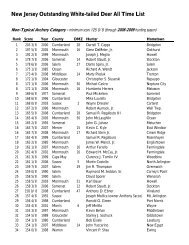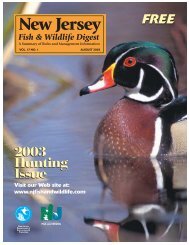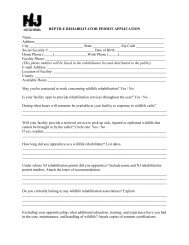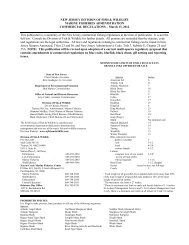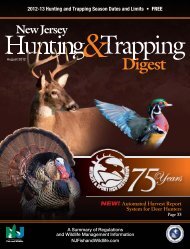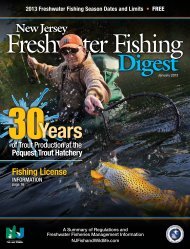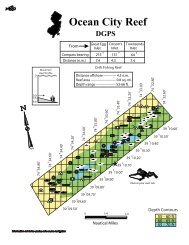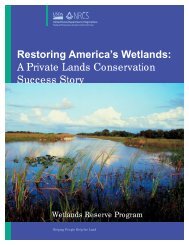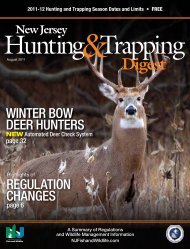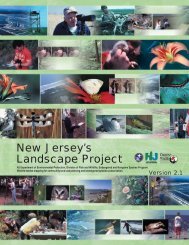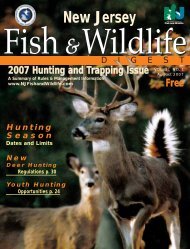Landscape Project Version 3.1 - State of New Jersey
Landscape Project Version 3.1 - State of New Jersey
Landscape Project Version 3.1 - State of New Jersey
Create successful ePaper yourself
Turn your PDF publications into a flip-book with our unique Google optimized e-Paper software.
18 | <strong>Landscape</strong> <strong>Project</strong> <strong>Version</strong> <strong>3.1</strong> | CONSERVING IMPERILED WILDLIFE OF NEW JERSEYSPECIES OCCURRENCE DATA DEVELOPMENTImperiled and special concern wildlife occurrence data are stored and managed in the <strong>New</strong> <strong>Jersey</strong> Biotics database.Developed by NatureServe, Biotics s<strong>of</strong>tware provides established scientific standards for biological inventory andbiodiversity data management used by most states, Canada, Latin America and the Caribbean, for tracking species.Imperiled and special concern species records within the <strong>New</strong> <strong>Jersey</strong> Biotics database are based on field observationsfrom a variety <strong>of</strong> sources including reports from the general public, ENSP surveys, and other pr<strong>of</strong>essional surveys,including those conducted by government agencies and environmental consultants. All records undergo rigorousevaluation performed by ENSP biologists for inclusion into the system according to an established protocol to ensurereliability (Appendix I). Moreover, in order for a species occurrence in Biotics to be used in the <strong>Landscape</strong> <strong>Project</strong>,it must meet the following additional criteria: the species status must be endangered, threatened or specialconcern; it must be a “high accuracy” record according to NatureServe (accurate within 6-50 meters[most fall within 20 meters]); it must have a 1980 or later last observation date; and it must be anoccurrence associated with habitat essential for survival such as a breeding or foraging site. For example,an occurrence <strong>of</strong> a migrating bird that is included in Biotics may not be included in the<strong>Landscape</strong> <strong>Project</strong> maps if it does not rely on habitat within <strong>New</strong> <strong>Jersey</strong> for survival.All occurrences receive a “location use class” as well as a“feature label” designation. Both <strong>of</strong> these are used torecord more information about the occurrence. A locationuse class is specified for migratory species and indicates theseason or behavior that is associated with the occurrence.A feature label describes the type <strong>of</strong> occurrence (e.g., nest,den, etc.). A single species occurrence may represent oneindividual animal (for example, a single timber rattlesnakeobserved on a rock) or multiple individuals (for example, atimber rattlesnake den supporting many individuals), distinctions indicated by the feature label.Timber Rattlesnake (Endangered) denssupport multiple snakes that return yearafter year to the same den location.ENSP has defined a “species occurrence area” (SOA) for every feature label assigned to a species (AppendixII). A SOA is a polygon specific to each species-feature label combination that is applied toeach occurrence location and used to value habitat in the <strong>Landscape</strong> <strong>Project</strong>. e size <strong>of</strong> each SOA isgenerally based on the average home range or territory size, or other appropriate life-history parametersas reported in peer-reviewed scientific literature, or from information obtained through ENSPresearch and expert opinion. In the context <strong>of</strong> the <strong>Landscape</strong> <strong>Project</strong>, a SOA represents the habitatthat supports the individual occurrence and <strong>of</strong>ten indicatesthe presence <strong>of</strong> a species population beyondthe individual documented occurrence. A depiction<strong>of</strong> the SOAs for different types <strong>of</strong> Indiana bat featurelabels is included in the table below.Data developmentprocess for speciesoccurrence areas.Indiana Bats (Federal Endangered) witha small cluster <strong>of</strong> Little Brown Bats at ahibernaculum in northern <strong>New</strong> <strong>Jersey</strong>.Feature LabelSOAHibernaculum4 kilometer bufferNon-breeding Sighting 2 kilometer bufferMaternity Colony2 kilometer bufferBreeding Sighting2 kilometer bufferIndiana Bat Feature Labels and SOAs





